2024
Music in Math Class
 Math teachers should start using music in their lessons. Music helps make students more engaged, creates a memorable experience and of course, it can be very fun. Loads of subjects in the mathematics program can incorporate music to show the beautiful relationship between the two. Why do some combinations of notes sound delightful while others feel like nails on a chalkboard? The answer lies in mathematics. Music can help bridge the gap between the theoretical and applied worlds of mathematics.
Math teachers should start using music in their lessons. Music helps make students more engaged, creates a memorable experience and of course, it can be very fun. Loads of subjects in the mathematics program can incorporate music to show the beautiful relationship between the two. Why do some combinations of notes sound delightful while others feel like nails on a chalkboard? The answer lies in mathematics. Music can help bridge the gap between the theoretical and applied worlds of mathematics.
In contrast to lower levels of mathematics where you can still imagine the material, higher level mathematics often becomes too abstract. Kids probably don’t like more complex math because they struggle imagining the subject matter. Using music for higher level math education can help get the connection back to the real world, Dr. Palina Salanevich, mathematical researcher at the University of Utrecht, explains.
In 2022 Turkish researcher Ayça Akın has shown using music in math lessons has a small to medium effect on improving math performance in students. Interestingly, really integrating music into mathematical concepts has shown to have the largest effect on student math achievement. But how can this be done?
Well, it’s time to bring a piano to class. Perhaps your own or one borrowed from music class, but a digital one works just as well. It’s also not necessary to be good at playing the piano, but this tool will prove essential for incorporating music into mathematics. This is because the piano can produce sound, but what does sound look like? Exactly, like a sine wave. Music is a great way to introduce the properties of this mathematical concept. The following is an example of a lesson plan focused on notes and sound waves.
Play a note and then the same note an octave higher, now show the corresponding sound waves. The sound wave of the higher note will go up and down twice as fast as the lower note, this can be used to introduce the concept of frequency.
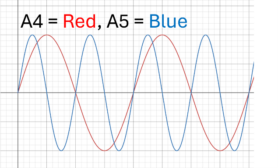
Sound waves of A4 and A5 notes
Amplitude can be explained by playing the same note twice, first quietly and then a lot harder. The sound wave of the louder note will go higher up and lower down.
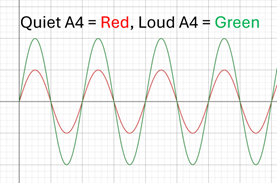
But why do some pairs of notes sound nice together while others don’t? ‘The A note’ sounds beautiful with the E but not so much with the B. This can be explained with the frequency, the E sounds nice with the A because the frequency of the former is almost exactly 1.5 times as much as the latter, meaning there is a ratio of 2:3. This means that there are a lot of moments where the sound waves come together, creating a harmonious sound.
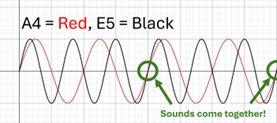
The B doesn’t sound nice with the A because the frequency of the B is approximately 1.12 higher than the A. The sound waves rarely come together.
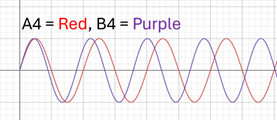
Another concept utilizing sound waves is the sound spectrogram. Palina Salanevich thinks Spectrograms are a great tool to get the physical connection back in higher level mathematics. A spectrogram is a way to visualize sound. The x-axis is time, the y-axis is pitch and the color determines the volume of a particular sound. Red is the loudest, followed by orange, yellow, green, blue, and finally purple.
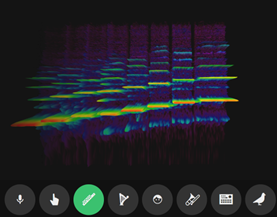
Using free programs like Chrome Music Lab, students can experiment with different instruments. For example, whistling has a very different spectrogram than one of a flute. While the flute and a whistling person both try to produce only one note, the flute has a lot of other noise at different pitches while the whistling person does not.
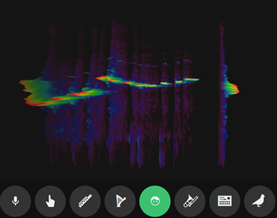
Because programs like Chrome Music Lab can generate spectrograms based on audio input, students can create their own spectrograms by making noise. ‘You can see that if you clap your hands or if you shout loud or if you whisper, how frequencies change, how intensities change.’ Salanevich explains. She confirms that in this way a student can connect what they do with their body with mathematics. In this way music is a great tool for embodied mathematics learning.
Yet, these are not the only ways to incorporate music into the mathematics classroom. Think about fractions and divisions with the rhythm of notes. Or use songs to memorize formulas like the ‘Quadratic formula song’ on YouTube. The possibilities are endless, it’s up to you to get creative!
Sources
Chrome Music Lab spectrogram
https://musiclab.chromeexperiments.com/spectrogram/
Music for math education
https://www.educationtimes.com/article/campus-beat-college-life/99735847/world-music-day-2024-music-helps-students-strike-a-chord-with-mathematics
Music helps math performance
https://www.tandfonline.com/doi/epdf/10.1080/03055698.2023.2216826?needAccess=true
Quadratic formula song
You must be logged in to post a comment.

